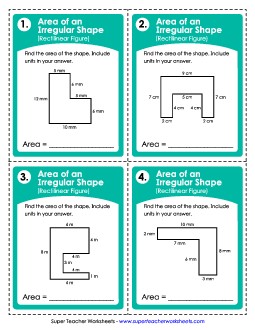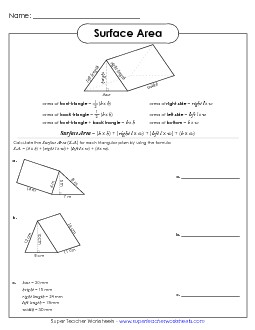Area Worksheets

Find the area of the shapes by counting the number of square unit tiles shown. These are very basic-level worksheets.
Areas of Rectangles and SquaresUse these free area worksheets and member printables to find the areas of the rectangles and squares by using the formula area = length times width.
Areas of Irregular Shapes (Rectilinear Figures)These worksheets have irregular shapes (made of 2 or more rectangles; rectilinear figures). Students find the areas of the individual rectangles and add them together.
Areas of CirclesThese PDFs have circles with the radius or diameter shown. Students must calculate the areas of the circles using the correct formula.
Areas of ParallelogramsHere you'll find a series of worksheets on area of parallelograms including a free classroom PDF.
Areas of TrapezoidsPractice finding the area of trapezoids with these task cards and worksheets.
Areas of TrianglesThis page has a collection of worksheets for calculating the areas of triangles.
Surface AreaCalculate the surface area of rectangular prisms, pyramids, cylinders, spheres, and irregular solid shapes using these free printable area worksheets.
Circles: Radius, Diameter, Area, CircumferenceThis page includes worksheets for calculating the areas of circles. Also features circumference, radius, and diameter.
PerimeterFind the perimeter of various polygons with these printable games, activities, and worksheets.



The concept of area is a fundamental math topic taught in both elementary and middle school, starting as early as third grade and continuing through middle school. Understanding how to calculate the area of various shapes, such as squares, rectangles, triangles, and circles, is an essential skill for students. In early grades, students begin by learning simple formulas, such as area = length × width for rectangles and squares. As they progress, they move on to more complex shapes like parallelograms, trapezoids, and circles, learning to apply different formulas for each. By working with these concepts through classroom activities, students gain a solid understanding of how to determine the space a shape covers.
Classroom methods for teaching area often involve hands-on activities that make abstract concepts concrete. For example, teachers might use grid paper, allowing students to count the number of squares inside a shape to determine its area. Manipulatives such as tiles or blocks can also be used to physically build shapes and measure their area. Group activities and interactive math games are found on Super Teacher Worksheets and will further engage students in practicing area calculations. As students move into middle school, lessons begin to focus on more challenging problems, such as finding the area of irregular shapes, and students are often tasked with applying their knowledge to solve real-world problems, such as calculating the area of a room or a garden.
Understanding how to calculate area is important because it is a concept that extends far beyond the classroom and applies to many real-life situations. From determining the amount of paint needed to cover a wall to calculating the space for furniture or the size of a plot of land, knowing how to find the area is a practical skill. Mastering the core concepts of area helps students develop spatial reasoning, problem-solving skills, and a greater understanding of geometry. By learning these skills early, students are prepared to tackle more advanced math topics and real-world challenges as they grow.






